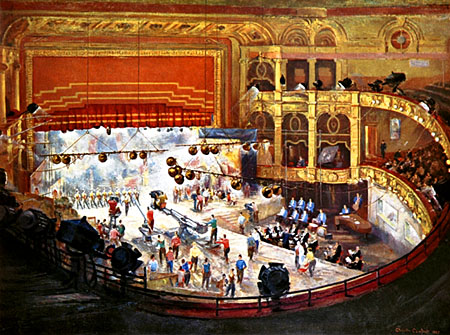
The Wood Green Empire originally opened on 9th September 1912 with a seating capacity of 1840 and stage 75ft wide wall to wall x 35ft deep. The property of Stoll-Moss, part owners of the new ATV company, it was used as a theatre until January 1955 when it went dark for a short while before being re-equipped by ATV. The first programme made here was on 22nd September 1955.
To cater for the needs of television production, changes were made to the interior including the enlargement of the stage area. The stage was built forward with a deep apron and extending on camera left all the way to the dress circle, giving a total stage area of 5295 sq ft. The control rooms and apparatus rooms were built under the camera right side of the dress circle. The audience was seated in the dress circle, which had a capacity of about 300.
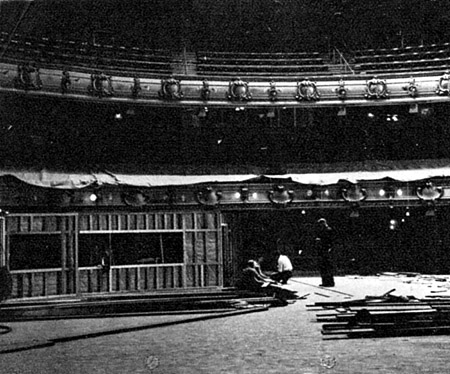
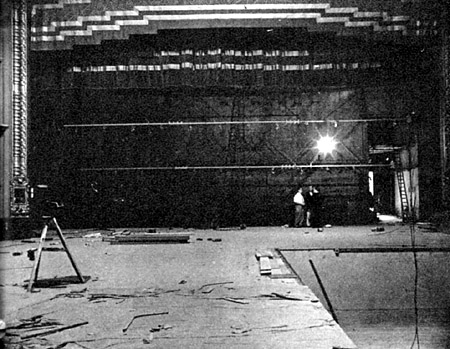
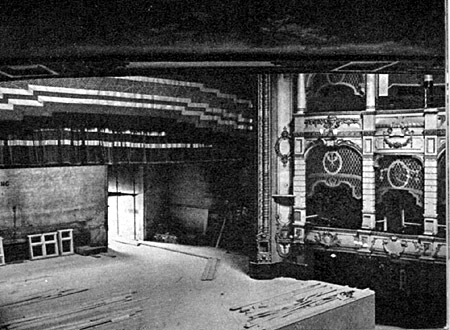
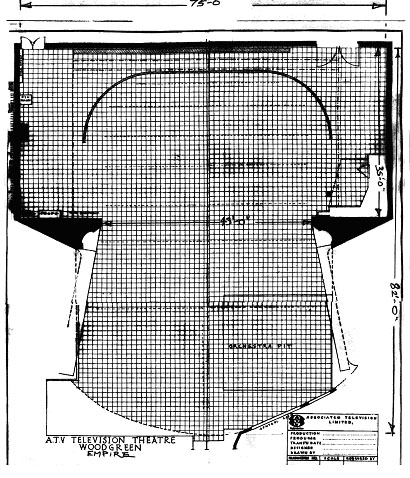
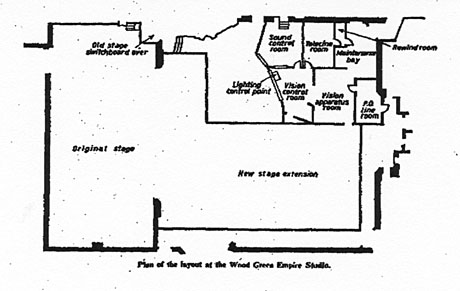
Lighting on stage was controlled by the theatre’s Grand Master which was situated in the camera right corner behind the proscenium arch. Oddly, there was another lighting control for all the front-of-house lights, which was in the vision control room (nowadays called the production gallery). Lighting changes must have been tricky to coordinate!
Within the auditorium were five lighting bars, each on a motorised hoist. The maximum lighting load was 300kW, consisting of Mole-Richardson ‘scoops’, and incandescent spots plus some Strand carbon arcs. The cameras were initially supplied by Pye and were Mk 3 three-inch image orthicons although only three plus a spare were in use. (These days entertainment shows use ten or more cameras.) However, later they were replaced by Marconi Mk IVs and I have received a note from cameraman Jeremy Hoare explaining why…
‘[Pye cameras] were used at Wood Green up until the remarkable man I was proud to work for, the late legendary Lew Grade, did a deal with an American network to produce some Dick Cavett shows, live from north London to the USA coast-to-coast with a five hour time difference to New York of course. So the Pyes were replaced by Marconi Mk IVs as these were switchable from 405 to 525 lines. These were good cameras also and delivered excellent pictures, and from my use of them as a cameraman, I found the viewfinder sharp enough to give me confidence to try shots that I wouldn’t have dared with the Pyes.’
(In fact, it seems unlikely that it was the Dick Cavett Show – David Heeley has written to say that he knows Mr Cavett and he didn’t have a show in the US at that time, so it must have been another talk show.)
Jeremy also told me about his experiences with the original Pye Mk 3 cameras…
‘The cameras at Wood Green, Hackney Empire and Foley Street Studios, and on Outside Broadcasts, were Pye image orthicons with four position turret lenses, typically 2”, 3”, 5” and 8”. In the studio, it was only the brave and foolhardy that used the 1½“ and 12” lenses, but everyone tried at least once, it was part of the learning curve. These cameras were way ahead of their time with electric lens change and focus demand, the latter switchable to either side, although the only person I recall anyone using the left side was my first Senior Cameraman, Ron Francis. When the focus control packed up on a live show, which was frequent, the side of the camera was opened up and the focus adjusted by sliding the tube carriage forwards and backwards manually. It worked and kept a camera going when the normal compliment was usually only three and sometimes, but rarely, four; so this was vital.’
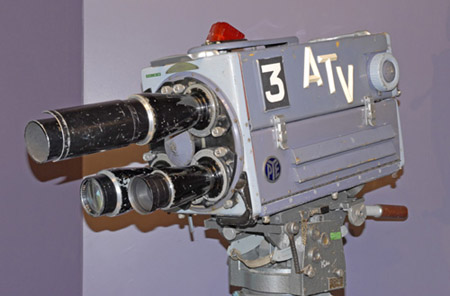
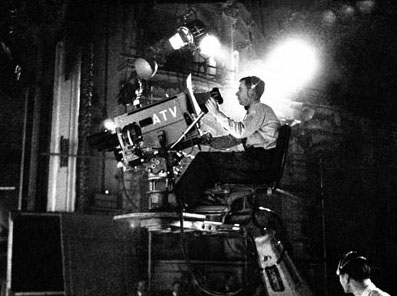
A telecine machine was also installed at Wood Green.
An unusual innovation in the studio was a cue-dot generator. This device enabled a small square dot to be placed in the top right corner of the screen 30 seconds before a commercial break, enabling ITV companies all over the UK to cue their commercials accurately. At first this was an experiment but later the system was universally adopted and amazingly in 2020 in this digital age it is still in use.
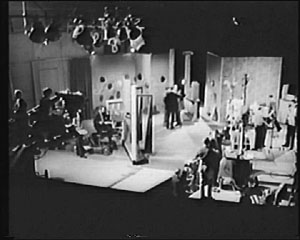
This still and the ones below are taken from a promotional film made by ATV.
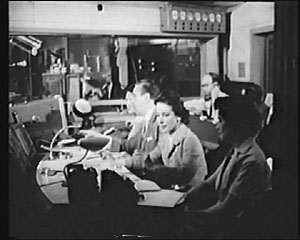
According to the plan, in the corner of the gallery was a ‘lighting control point.’ One assumes therefore that the gentleman sitting in the background of this picture must be operating the lighting. I’m intrigued by the panel above the window. It has seven sections. Seven? What could it possibly have been? My guess is that it controlled the lighting hoists in the auditorium. Another source says that there were only five of them but maybe there were seven after all.
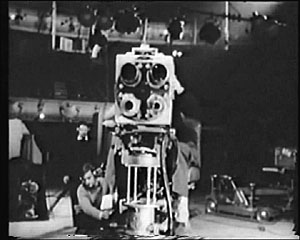
The Wood Green Empire was the home of ATV’s scenery workshops and their OB fleet was also based there. In 1957 the studio produced about seven hours of programming a week. The theatre was linked to ATV’s Highbury studios via landlines, whence the signal was sent to their continuity and playout suite in Foley Street.
The studio was used to make all kinds of programmes including LE, drama and children’s. I have also been told by more than one ex-employee that Emergency-Ward 10 began here before moving to Highbury. Examples of contrasting shows include Val Parnell’s Saturday Spectacular, a sitcom called Joan and Leslie (starring Joan Reynolds and Leslie Randall) and various 90 minute plays. Rosemary Wenzerul has been kind enough to contact me. Her late father, Barry Molen, used to run the canteen and collected many photos of the stars who performed here. She has confirmed that Emergency-Ward 10 was indeed made at Wood Green for a while. She has also sent a picture of the Randalls with a dedication from them to her father.
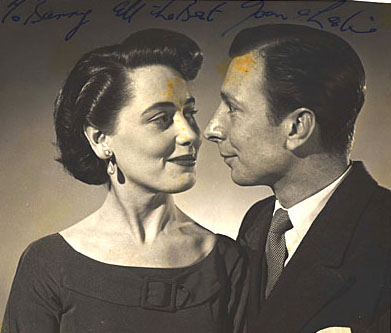
I must confess I hadn’t heard of the sitcom but it seems to have been very popular and has its own page on the IMDb.
Amongst the plays was probably The Voodoo Factor – a spooky tale starring Maxine Audley based around her character’s fear of spiders. There is a possibility that this was made at Highbury but Wood Green seems more likely. Other programmes recalled by people include The Sid James Show and The Strange World of Gurney Slade (’60) – a bizarre and sometimes disturbing comedy starring Antony Newley. Interestingly, it was shot on film rather than using the studio’s TV cameras.
Jeremy Hoare has written to me about his not very happy experience on this show…
‘I was still an ATV Trainee Tracker when I was unusually scheduled to a film unit for a day at our Wood Green studio on the Anthony Newley show, ‘The Strange World of Gurney Slade’. The sequences that were shot at Wood Green that day were on 16mm film using a blimped Arri BL mounted onto the manual Vinten Pathfinder dolly. As the sole tracker I was very much an outsider as they were superior ‘Film’ people and I was a merely a ‘Telly’ person, they made this clear from the start, I was being tolerated.
One shot I remember particularly involved a track-in from Long Shot to Mid Shot. We rehearsed and I put my marks on the floor then we went for a take.
“Camera!, Action!” and I pushed the Pathfinder in on cue and timed it correctly so I ended on the right part of Newley’s speech although I was about an inch to the right of my mark but directly alongside it, fairly normal. I had just got there when the camera operator shouted ‘Cut, no good!’ stopping Newley mid sentence. He turned round and without looking at the floor said to me, “You’re off the mark, we’ll have to do it again!”. He was right but this was normal because unlike film, we hardly ever use tracks or rails in television (which would guarantee a set re-position) so I mumbled something like an apology and he said in a flamboyant Prima Donna manner, “Okay then, I’ll just have to unlock the pan if that’s the best you can do!” I was furious because no television cameraman to my knowledge before and subsequently since has ever locked the head controls where it could be possible that a misframe would occur. It was and is normal for a cameraman to make small adjustments, actors are not always good at hitting marks, so often compensation in framing is needed.
We did another take and I hit the mark exactly but the operator said nothing to me. We moved on to the next set-up but at the end of the day’s shoot I went home more than a little upset that this had happened. I was still a trainee and just nineteen at the time so probably over-reacted as one does at that age. Fortunately I found out that not all Film Camera Operators were the same. I worked later with the terrific Frank Watts on a promo shoot in a tiny studio in the basement of ATV’s Great Cumberland Place office block and he was good enough to show me a lot about how a blimped Arri functioned which more than compensated for my first experience. I thought better of film people after that!’
As has often happened over the past few years, what seems a simple account recalled by someone in good faith is questioned by someone else. In this case, Phil Ashby reckons the film camera Jeremy describes could not have been a blimped 16mm Arri BL since this didn’t come out till 1965. Having seen the show in question with a group of editors projected on a screen he reckons it must have been a 35mm Mitchell. However, I have also been contacted by John Stewart, who thinks it may well have been a Arriflex but of a different model. He suggests that if 35mm it was a probably an Arriflex 35, probably a IIB. He says that with a blimp it was a very useable studio camera. If it was indeed a 16mm camera he suggests it could have been an Arriflex ST, which could be used with a blimp for sound shooting.
Anyway, Jeremy’s story is still a very good one.
It is perhaps worth reprinting part of an article from ‘Practical Television’ published in January 1957. The writer describes a visit to the studio:
I drove my car up to the front of the Wood Green Empire – only to find it was not there! The entire façade, canopy and other front-of-the-house paraphernalia had disappeared, and in its place were brightly-lit dress shops. As I made my way around a side road to the stage door, I fancied that I heard the ghosts of [the] great illusionists [who had previously performed there] chuckle and say ” Abracadabra! ”
Fortunately, the stage door was there, quite solid, almost hidden behind a pile of new scenery and stage properties, and the back of the theatre seemed to have been extended. I discovered at once that additions had been made to the backstage facilities, particularly as to make-up, wardrobe and dressing-rooms. The old music-hall atmosphere persisted; there was no dressing-room 13 – instead, there was 12A! Crossing my fingers as I went under a ladder, I wandered on to the stage to meet Bernard Bibby. ATV’s Chief Engineer of studios and O.B.s. Mr. Bibby is an ex-BBC man (from Lime Grove and the Alexandra Palace) and he brought me down to earth rapidly with facts and figures, including lighting three cigarettes with one match.
What surprised me at first about the above is that the foyer and main entrance appear to have been sold off and turned into shops by ATV. One wonders how they handled their studio audiences – some sort of entrance and foyer would surely have been needed. However, it does seem likely that there was an entrance in a side street that led to a foyer upstairs. After all, with no audience in the stalls, only the circle foyer would have been needed.
The theatre had its orchestra pit on the camera right side of the auditorium. However – for one show, designer Richard Greenough thought of another use for it…
‘At Wood Green I designed a show for Jimmy Jewel and Ben Warris. There was a sketch with them in a boat. For this we filled the orchestra pit with water. A plastic liner was made and this worked very well except I had designed steps to get down into the water but these were made of wood so they floated up! We also had an inverted periscope to get an underwater shot. This worked very well during the rehearsal but by the time of transmission the water had become very cloudy. As this had worked well we did it again in a later show but this time the plastic liner sprung a leak and the water began to get into all the electrical wires under the stage. Panic! Bob Craig, the stand-by carpenter, volunteered to go down into the water so I lent him my bathing trunks which were in my car. Somehow he managed to stem the flow and the show went out live. We did not repeat this mistake.’
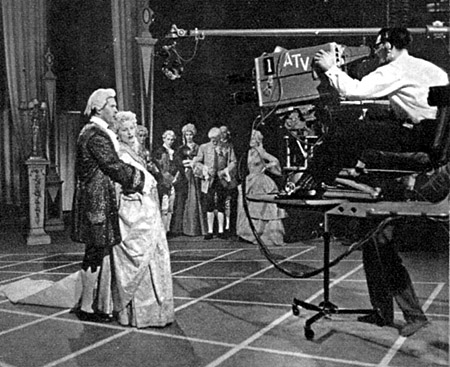
ATV used the Wood Green Empire through to 29th May 1963 – interestingly, well after all the studios at Elstree had opened. After that the theatre stood dark for a couple of years before the stage, backstage area and most of the auditorium were demolished to make way for a multi-storey car park. The façade is just about recognisable today, in the centre of a parade of shops. Last time I looked it was a branch of the Halifax but the original arrangement of foyer door and an entrance either side can still be made out – as can the typical Frank Matcham grand roofline with two small ornamental domes.
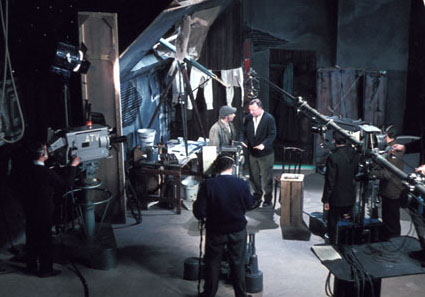
Just a little postscript – Frank Barker has contacted me with a couple of memories. He collected autographs there from 22 Sept 1955 (opening night) to around 1960. He recalls that the access to the upper circle and balcony was in Lymington Avenue and the one to the circle was in the side alley connecting front and back. Blue tickets for circle, white for UC. He also informs me that initially, the refreshments for artists were located in an ex shop before a purpose-built restaurant was opened adjacent to the stage door. Two performances stood out for him – the Oh Boy! pilot in 1958 and Nat King Cole’s show some time later. Happy days.

